What is filigree and where is it used?

Many homes have jewelry. And, perhaps, many of their owners have heard the word filigree, especially when it comes to jewelry. However, not everyone knows what filigree is. This jewelry technique will be discussed in the article.

What it is?
The word "filigree" has two meanings. On the one hand, it means a special pattern of metal wire applied to any metal thing. Another option: filigree is a craft that involves the very process of creating a pattern.
This word looks like filigree in English, and comes from the Latin language. Thus, filigree consists of two Latin words: filum and granum. The first means "thread" and the second means "grain." The name contains the whole essence of the word. A thread is a metal wire, which, like an ordinary thread, is very thin. Grain, on the other hand, is both metal balls applied along with the wire and jewelry, that is, work with small details. Indeed, it takes a lot of time and effort to apply a filigree pattern.

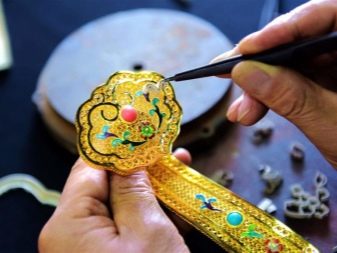
In Russian, filigree is called filigree. As in English, in our speech this word also did not appear just like that. In Ancient Rus there was a word "skat", which meant to twist or twist. It was from him that the name of the jewelry pattern came from.
Let's figure out what the filigree technique is.
- Any precious metal is taken, as a rule, it is silver or gold.
- A very thin strip is made of them, from which the pattern will be created. At the same time, it is very important that precious metals are pure, without impurities. Otherwise, the wire will not be as elastic. Only pure specimens can be used to make the finest thread.
- In the future, the threads are fixed on a pre-prepared background in the form of a pattern.

Silver and gold are used as materials not only because they are considered the most expensive and valuable, but also because they are soft metals. Unfortunately, the final product, created from not the most durable materials, is not very resistant to physical stress.
After the main pattern has been applied, the artisan proceeds to the next stage, namely, the application of metal grains. They will decorate the final product, giving it a certain volume.
Filigree is one of the basic techniques that has been known all over the world for many years. Any jewelry maker should be able to work with this technique as well as high quality carvings. With its help, various patterns are created on many jewelry items, this is how precious items are decorated.


History of origin
Some people mistakenly believe that filigree is a primordially Russian craft. Of course, historians cannot determine exactly when and by whom this technique of creating jewelry patterns was invented. but Numerous excavations and many years of work by scientists have made it possible to find out that filigree first appeared around the 5th century BC in Egypt, Greece and some other countries of the Ancient World.



A little later, this technique appeared in other states, such as Portugal, Spain. In Russia, filigree appears, but historians cannot name the exact date. With the onset of our era and for some time, filigree was not very popular. This is evidenced by the number of finds and the location of their discovery. But already in the 17th century, the demand for such products increased sharply. From this moment, the rapid development of this craft begins, new types and techniques begin to appear.


In Russia filigree reaches its peak in the 16th century. Masters in this business created real works of art. Surprisingly, even under Soviet rule, this craft did not disappear, but even, on the contrary, rose several steps higher in its development. The Russian city of Kostroma is the informal capital of the Russian filigree.
After the industrial revolution in European countries in the 19th century, filigree elements became a factory commodity. At this point, there is a huge selection of various dishes, vases, caskets and many other things with such decoration. Thanks to the new method of their production, the cost in the market becomes much lower.


Species overview
Of course, all the time since the appearance of filigree art, it has been developing incessantly. Development took place in all directions, more and more patterns of patterns appeared. As a result, there are several very different species in the world today.

Soldered
This variety differs in that the soldering of metal wire and grains occurs on some basis, on which they ultimately, in most cases, remain. Depending on various factors, there are several subspecies of soldered filigree.
-
Background. In another way, she is called deaf. This subspecies is considered to be the simplest. Its essence is that the pattern is applied to some kind of background. Moreover, after applying the filigree, it is not removed anywhere, moreover, it is part of the entire drawing.


- Perforated. Its other name is drink. This variety is the complete opposite of the previous one. Here, after the pattern is applied, the background is removed. And this is done by cutting and sawing. From the methods of getting rid of the background, there are two names for this subspecies.

- Embossed. The difference here is the background itself. This is not just a flat sheet of metal, but a chased relief. Thanks to this, the final pattern turns out to be more beautiful due to the acquisition of a small volumetric relief.

- Cloisonné. Otherwise, it is called soldered with enamel. To create a pattern of this type, enamel is used. Initially, the filigree is soldered to the base, but after that the work is not finished.The space between the partitions of the pattern is filled with enamel.

A soldered look is also called a consignment note. This is because the pattern is, as it were, "superimposed" on some background. This opportunity allowed many craftsmen to use ornament to decorate their products. Sozh filigree can be cited as an example of this type - this is a Belarusian technique, such products are appreciated all over the world.


Volumetric
The name of this species was invented for a reason. Unlike the soldered pattern, this variety does not need any base and, accordingly, a background. Using metal threads, the master twists them in such a way as to obtain three-dimensional figures.

Some products are much more convenient and correct to do not immediately. The creation of difficult volumetric filigree products requires breaking down one large task into several small ones. Simply put, a skilled craftsman initially makes only parts of the future pattern. At the same time, due to the fact that the master does not need to be distracted by the whole figure at once, it turns out to achieve greater concentration for point work on each small element. After that, the final pattern is assembled from the parts made.
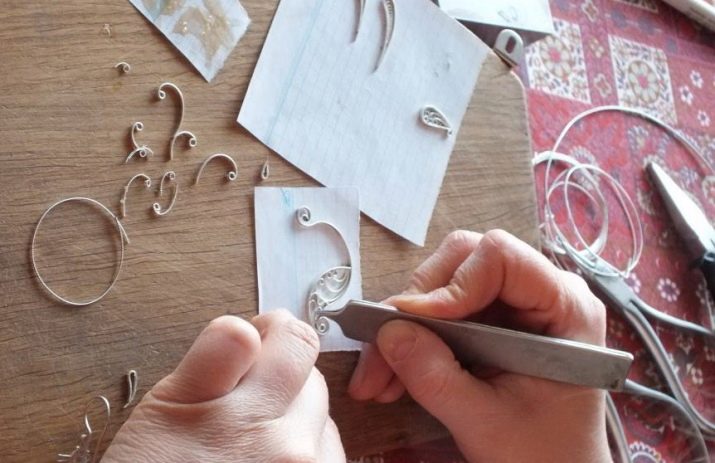
Due to the fact that, as such, this filigree does not have a basis under itself, its strength is much less than that of the same soldered type.
An example is the Krasnoselskaya filigree. The master of this technique calls his products openwork-volumetric. Their products are constantly demonstrated at various exhibitions both in Russia and abroad.
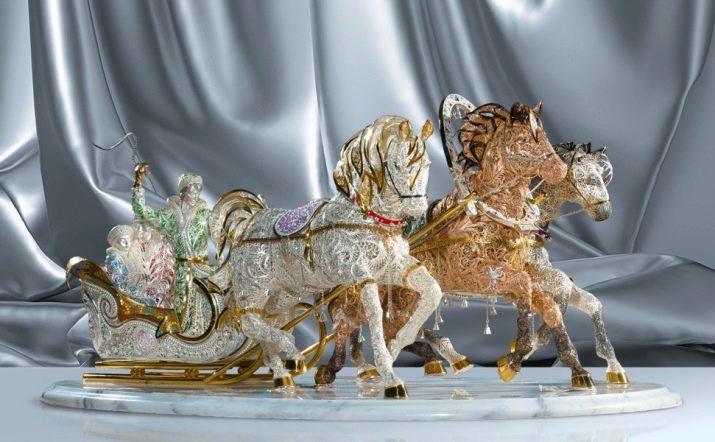
Openwork
A pattern of this type is somewhat similar to a volumetric variety. But there is one difference - openwork products can be flat as opposed to volumetric ones, which are always made in a 3D style. The similarity between them is that both species have no basis either at the time of their creation or in the end.

The process of creating openwork products as a whole does not stand out in anything special. Expensive and soft metals are also used here, metal balls or grains can also be used. The main interest of openwork products is caused by embossed products. Unlike volumetric ones, such decorations still remain flat, but thanks to various protrusions and irregularities, they become more beautiful.

A striking example of openwork filigree is Kazakov's filigree. This is a very popular technique in which a wide variety of shapes and decorations are produced. And also very well demonstrates the openwork style of the Kostroma filigree. Kostroma itself is the birthplace of such patterns. This explains the skill of the products that are produced using this technique. The lumpy filigree is also a representative of the openwork type, which is produced by Tatar craftsmen.

In all of the above varieties, the technology of precious lace is very often used. In fact, this is a kind of technique by which a metal thread is wrapped in a pattern. The peculiarity of this technique is that for openwork and voluminous products, the maximum final strength is ensured.
Areas of use
Today, products decorated with a filigree pattern are very popular. They are bought as a gift for birthdays, New Years, anniversaries, anniversaries, or just for yourself. The scope of application is huge, they include a huge number of different dishes, bijouterie or jewelry.

One of the old cutlery is the cup holder. Nowadays, it can be used to create an authentic setting, but it also works great as a common interior decoration. Many people inherited this item from the older generation - grandfathers and grandmothers. Because of this, the color of such cup holders has slightly changed due to time. So, the silver from which they are made is no longer so bright, but dimmer. Still, a filigree or filigree cup holder looks great in modern homes.

Another item that may have come from my grandparents is the box. Of course, today this item can be easily purchased in jewelry stores. The filigree jewelry box not only looks beautiful but can function perfectly. So, this box is perfect for storing family heirlooms or jewelry.

To decorate your home, you can purchase a filigree table clock. As with the box, the item will be fully functional. It is also important to note that the table clock is always placed in the most prominent place. Thus, it will be possible to see all their beauty all the time. Due to the structural features of watches, filigree is made on them by soldering, while additionally metal balls can be used for greater aesthetics.

Filigree vases are often purchased along with watches. The patterns on them can be made not only with silver, but also with gold threads. Vases are usually used purely for decoration, but if desired, you can use it for any need. And also vases come in very different sizes. There are large floor vases, and there are small ones that will look great with a clock on the same table.


Filigree is often decorated with men's accessories. For example, filigree for a cigarette case will look great. Nowadays, few people use this thing, more often they treat it as a work of art. The craftsmen make the patterns on them in a variety of ways, using both silver and gold. Of course, cigarette cases decorated with gold threads will be more expensive, but in many cases the use of gold is indeed preferable to silver.

The male ring is also included in the scope of filigree use. Moreover, such accessories were highly popular among men at all times. The most important feature of a ring that distinguishes it from a ring is the presence of a gem on the outside. The stone can be anything depending on the price of the whole ring. Filigree on such things is a rather laborious thing, because the master has to make a pattern on a very small surface.

In general, rings are not only male, but also female. There are no fundamental differences in them, except that the style will be different.
Something similar to a ring is a pendant. However, the presence of a stone in it is optional, although it is encouraged. The pendant is hung around the neck and is an antique jewelry. Moreover, such a thing is an exclusively female accessory. Filigree on a pendant can be of various types. It can be soldered filigree applied to the base of the pendant, and openwork filigree, and sometimes even voluminous.

In this case, great opportunities for creativity open up for the master, since different types of pendants can be of absolutely any shape.
Filigree is also used in the manufacture of bracelets. Openwork or brazed filigree is used. Interestingly, filigree bracelets are among the most popular and expensive goods among women. Of course, the material of manufacture plays an important role in the price: gold items are many times more expensive. Bracelets can be either wide and flat, or have the appearance of a chain.

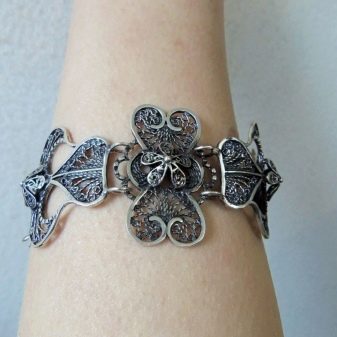
In both cases, it is very important which filigree pattern is used. Indeed, in such things not only is the thing silver or gold, it is important that the drawing is really worthy.
The filigree chain can be used for a cap. This decoration was especially popular in those years when the cap itself was in vogue. However, even now some firms are engaged in the production of filigree chains.

Women can look after themselves filigree earrings. The modern world is such that the variety of these accessories is off the charts. You can choose earrings for any outfit, while their cost may not be very high. Filigree earrings differ in that they are always quite large. In general, such a decoration is not for everybody.
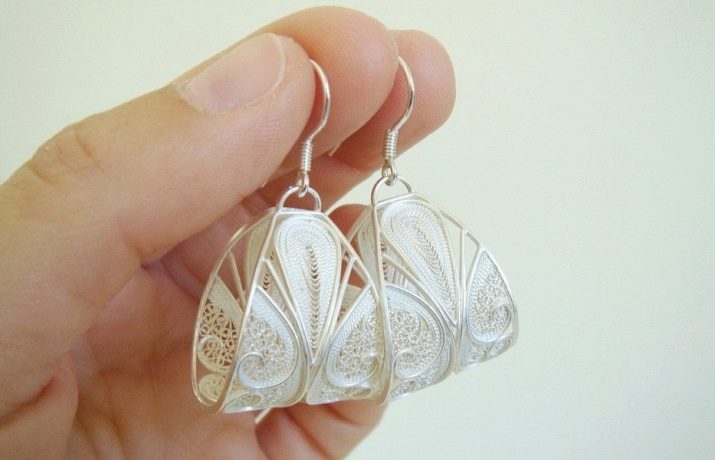
And, of course, brooches were also included in the art of filigree. A huge number of products on this market are brooches, decorated or made entirely with this technique. The most interesting thing is that even brooch bases are made in the same way.

In addition to everything listed above, filigree technique affects various dishes, rings, necklaces, crafts and much more. The most important thing is that despite such a variety of different jewelry items, they are not all made according to the same stencil. Of course, there are also similar, identical patterns, but for the most part each thing is unique - it is almost a work of art.

Filigree is a special technique for creating jewelry designs. It has a rich and ancient history. There are several types of filigree, each of which is commonly used in jewelry and tableware production. In general, we can say that the scope of the use of scanning is really huge.

For information on how to make filigree jewelry with your own hands, see the next video.






